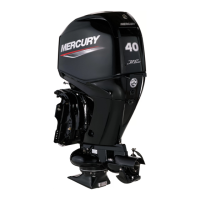
Do you have a question about the Mercury Jet 40 and is the answer not in the manual?
| Horsepower | 40 HP |
|---|---|
| Cylinders | 3 |
| Weight | 240 lbs (109 kg) |
| Steering | Remote |
| Displacement | 45.6 cu in (747 cc) |
| Starting | Electric |
| Full Throttle RPM Range | 5000 - 6000 RPM |
| Fuel Induction System | Carburetor |
| Alternator Output | 18 Amp |
| Shaft Length | 20 in |
How to transfer the limited warranty to a subsequent purchaser.
Process for registering warranty for products sold in the US and Canada.
Process for registering warranty for products sold outside North America.
Details of the two-year limited warranty for Mercury Marine products in Europe.
Details of the one-year limited warranty for specific regions outside North America.
Specifics of the three-year limited warranty covering corrosion damage.
Clarification of what is covered and excluded under the warranty.
Operator's duties for safe boat operation and occupant safety.
Essential checks and information required before operating the outboard.
Importance of matching the outboard to the boat's maximum horsepower rating.
Requirements for remote control systems used with the outboard.
Safety warning regarding the proper fastening of steering link rod components.
Function, operation, and safety precautions for the lanyard stop switch.
Procedures for emergency stopping of the jet drive boat.
Safety measures to prevent injury to persons in the water near the boat.
Hazards and precautions associated with jumping waves or wakes.
Information on carbon monoxide poisoning and necessary ventilation.
Guidelines for choosing and installing compatible accessories for the outboard.
General advice and suggestions for safe boating practices.
Importance of recording and referencing the outboard's serial number.
Diagram identifying the main external components of the outboard.
Instructions and safety warnings for properly mounting the outboard.
Recommendations for safely trailering a boat with the outboard.
Guidelines for selecting the correct type and octane of gasoline.
Specifies the required type of 2-cycle oil for the engine.
Procedure for breaking in a new engine using a specific fuel/oil mixture.
Overview of different remote control types and their functions.
Description of the audible warning system for engine conditions.
How the engine's over-speed protection mechanism functions.
Operation and benefits of the power trim and tilt system.
Procedure for manually tilting the outboard.
Using an auxiliary switch to tilt the outboard.
Operation of manual tilt systems on models without power trim.
Adjusting the throttle friction for tiller handle models.
Adjusting steering friction for tiller handle models.
Function and location of the jet drive shear key.
Essential checks and procedures to perform before starting the engine.
Precautions and procedures for operating in freezing conditions.
Care and maintenance guidelines for operating in salt or polluted water.
Considerations for operating the outboard at high altitudes.
Safe operating practices in shallow water to protect the jet drive.
Explanation of the jet drive propulsion system's functionality.
Procedures for emergency stopping of the boat using the jet drive.
How to effectively steer the boat using jet thrust.
Proper procedures for mooring the boat safely.
Causes, symptoms, and solutions for water intake blockages.
Steps to free a lodged impeller in the jet drive.
Instructions for the initial break-in period of a new engine.
Step-by-step guide for starting the outboard engine.
Explanation of the outboard's gear shifting positions (Forward, Neutral, Reverse).
Procedures for safely stopping the outboard engine.
How to start the engine using the emergency starter rope.
General advice for maintaining the outboard's optimal operating condition.
Information regarding the emission certification label on the engine.
Schedule of required inspections and maintenance tasks for the outboard.
Procedure for flushing the outboard's cooling system with fresh water.
Steps for safely removing and reinstalling the engine's top cowl.
How to inspect and maintain the boat's battery for starting capability.
Safety precautions and maintenance procedures for the fuel system.
Instructions for cleaning and waxing the outboard's exterior finish.
Importance of using correct fasteners for steering link rod connections.
Procedure for replacing a blown fuse in the electric starting circuit.
Function and maintenance of the corrosion control anode.
Procedures for inspecting and replacing spark plugs.
How to adjust steering to correct a pulling condition.
Symptoms and causes of a worn or dull impeller.
How to adjust the clearance between the impeller and the liner.
Step-by-step guide for servicing the jet drive impeller.
Locations and types of lubricants for various outboard components.
Procedure for checking the fluid level in the power trim system.
Immediate service requirements for an outboard that has been submerged.
Procedures for preparing the outboard for out-of-season or prolonged storage.
Methods to protect external outboard parts from corrosion and damage during storage.
Methods to protect internal engine components during storage.
Correct orientation for storing the outboard to allow water drainage.
Guidelines for storing the boat battery safely.
Diagnosing issues when the electric starter motor does not engage.
Common causes and solutions for an engine that fails to start.
Troubleshooting common causes for erratic engine performance.
Diagnosing and addressing conditions that cause excessive engine RPM.
Identifying potential causes for reduced engine performance.
Troubleshooting issues related to the battery not retaining charge.
Recommendation to use authorized local dealers for servicing.
Guidance on finding service when traveling away from the local dealer.
Information on where to direct inquiries for parts and accessories.
Steps to follow for obtaining assistance with unresolved service issues.

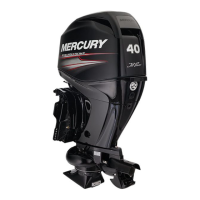
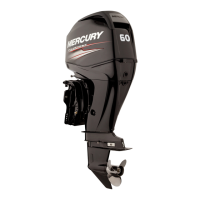
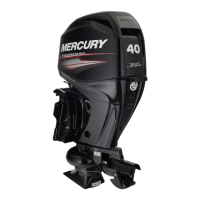
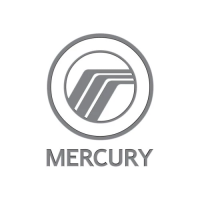
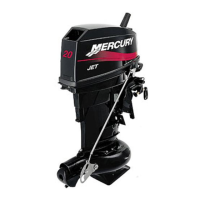


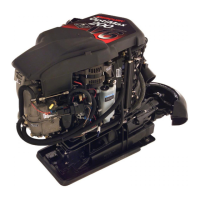
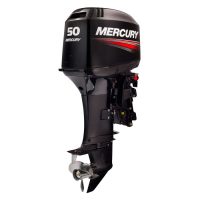


